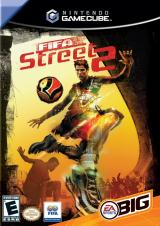European Football purists aren't likely to enjoy FIFA Street 2 any more than they did the first game in the series. Like its predecessor, this is an arcade-style game in tune with EA's other alternative sports titles, such as NBA Street. As such, it's more about flashy tricks than the actual game of soccer, although it's entertaining enough for what it is. The artificial intelligence is improved and ball physics are much more realistic than in the first game, but while FIFA Street 2 makes a good first impression, it gets bogged down by unresponsive player controls and repetitive action.
Part of the great initial impression is the exhaustive player creation utility that lets you customize your player from a variety of options, as well as detail your home pitch with enough details to make it interesting. Granted, the pitch editor isn't as full-fledged as it could be, but the result can be as downtrodden as you want, even if the forced grittiness of it is sometimes hard to swallow. You can't adjust its size and shape, so aside from cosmetics, there's no real value in one pitch over another. Your players, however, have adjustable stats in speed, tricks, and so forth. And while your player and pitch may look as downtrodden as you like, as the game wears on, you'll notice it pretends to be more urban than it really is, like a guy in the Hamptons claiming he grew up on the streets.
Once you're finished, you take control of a four-man soccer team that competes against similar teams with a fascinating mishmash of fictional street players and actual soccer stars. A lot of popular stars from around the world are curiously absent, although in the end, it matters little: you don't play a lot of soccer in FIFA Street 2. Instead, your goal is to string together tricks, and there are plenty more of them this time around. Pulling them off is intuitive, thanks to the use of the right analog stick, which serves as both an offensive tool and performs defensive tackles. Winning isn't just a matter of scoring goals, which is more often than not your secondary mission, since several modes don't even require goals, instead focusing on trick points.
The smoother aspect of the controls is completely at odds with the defensive gamebreaker moves, which work well when you're successful -- but start a string of frustrating and uncontrollable animations when you aren't. Should you counter the offensive player with the right move, you take control of the ball, and in turn, get to enjoy the better parts of the game. Should you aim in the wrong direction (and it's always a crapshoot, since you are simply playing the odds), you get stuck for a few seconds waiting for your player to finish the fake-out animation. There are other defensive moves, of course, but they only require some button mashing and miss the finesse of the better offensive juggles and shots. The result? It's easy -- and preferable -- to beat your defenders and stay on the offensive as often as you can. Too bad playing defense just isn't much fun. You can take manual control over your goalie, although this isn't as interesting or as helpful as it sounds.
You'll have to master as many tricks as you can, thanks to the varied modes, which may award points for certain tricks like the panna (more commonly known as the nutmeg), or for making gamebreaker goals. The biggest issue with that is that while the varied modes sound great on paper, in practice, it's too predictable to stay interesting. Outplaying AI defensive opponents is all too easy until you get to the goalie, who is brilliant one moment and harebrained the next, depending on the complexity of the combo you built the shot from. Whether your mission is to perform nutmegs or goals, the standard match ends up being a bunch of juggling moves, some passes, a bunch of trick moves, and a shot at the goal. In fact, the juggling is the best part of the game, although you wouldn't know it from the excruciating juggling challenges, which play like a dumbed down version of Dance Dance Revolution.





 Average
Average



